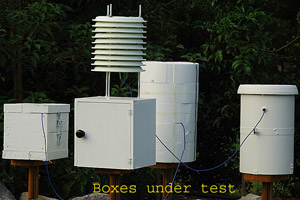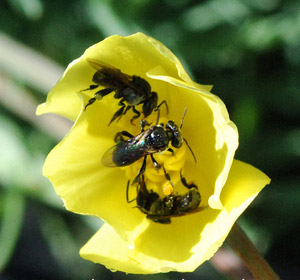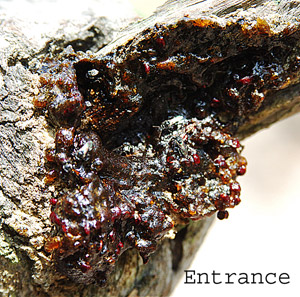Bob the Bee ManThis web page is for anyone who may come into contact with the stingless native bees of Australia . I see this group of people primarily as tree loppers and vegetation management workers, firewood cutters, earthmoving contactors, timber getters of all types and the farming community.
Click here to contact me
I aim to rescue and relocate as many colonies of these fascinating little bees, in hives which are under threat, as I can. If the tree has to come down, then I will come to get the bees (not feral honey bees). If time or distance prevent that, I will pass on what information I can and perhaps contacts who may be able to help achieve a safe outcome for the bees. If a little information is all that is needed for the bee colony to be safely relocated without my attention, I am happy to provide that by phone. My activities include boxing some colonies to investigate what is needed for the domestication of these bees, for the production of honey, and researching optimum box designs. We have little information
All are approximately 4 – 5mm long, nearly black in colour, are unable to sting and seek hollows in trees as nest sites. Though they cannot sting they respond quickly to disturbance by biting any areas of tender skin, and getting into ears and up the nose of the offender literally. Generally their displeasure is obvious, and they have learnt that the vibrations of a chainsaw are to be defended against and target the operator quite vigorously. This is a sign of a healthy colony as well. They have adapted to other hive sites and have been recorded in a wide range of sometimes unlikely cavities. Concrete block walls provide an apparently unending expansion ability. Water meter pits are popular. Telstra boxes and pits, discarded tyres, incinerators, polystyrene boxes, wall cavities, even gravestones are a few examples. A few have managed the seemingly inhospitable cavity inside exposed steel pipes in structures.
Only that you give me a phone call if, and when, you come across one of these colonies in tree removal operations. I am normally available during the week, and will come to collect the colony from the site. When I get there I will secure the colony by capping the ends of the log and blocking the entrance of the hive after I have given flying bees a chance to return. It can be removed immediately but I prefer to give the flying bees at least some time to relocate the hive, especially if the nest has been cut into. In this latter case I will seal the cut up with a non-toxic and non-sticky sealant(No More Gaps) and then tape the cut to prevent the entry of other insect pests that can destroy a colony. I have even taped on struts to splint long sections together. If the hive is in a badly damaged section of tree, it is possible to put the hive material into a box hive and then give the bees some time to find their new home before removing them. The more flying bees that are collected the better the chances of survival for the colony. I am happy to offer some recompense for your troubles if that makes the difference between you phoning me or abandoning the bees to the chipper or woodheap. They can have a value so please do not destroy them without talking to me. If you do happen to have a number of displaced hives I am happy to box every 3 rd hive and leave the boxed hive with you at no charge if you are interested in starting in the keeping of native bees. What should you do for best chance of success? If you find a native bee colony in a tree that you are, or will be, working on, then call me and I will come as soon as possible or provide suggestions if you have to deal with it. Locate the entrance and cut perhaps 60cm above and below it in normal felling operations. It the hollow is less than 10cm in diameter, then 75cm above and below is safer. Then just put that section of tree aside for me to deal with when I get there. If one of the cuts does go through or into the nest, just make another cut further away from the entrance and put the 2 pieces together as best you can. I will patch them when I get there. Handle the logs as gently as you can. Please do not seek to remove honey and nest material as spilt honey is a common cause of loss of disturbed hives .I can organise that as I box the hive. If you call me to collect a colony and think that you will have more, I am happy to leave a basic ‘native bee rescue kit’ with you so that future finds can be looked after, if I am unable to get to you for any reason. If you find a colony and don’t want to phone me? If you don’t want to call me but would like to try to save the hive, the most important thing is to put secure caps on each end and repair any cuts into the nest hollow, make sure the hive is placed the same way up as it was in the tree, orientation is important. Make sure what was up, stays up. Using a non-toxic sealant like No More Gaps, nail or screw pieces of timber/ply/metal over the exposed ends of the log to seal the hollow from ants and other insect pests. Do this as soon as possible after cutting the hive from the tree. If possible mount the log so that ants don’t have free access until the bees have re-established defences. A heavy log section can be supported by 3 star pickets for example. Lighter logs would take only one or 2 depending on shape and weight. Apply a little grease around the star pickets below the log to deter ants. As a minimum put the log up on a block. Find a place to locate the hive that is safe from livestock, vehicles, people etc. Morning sun is an advantage but shade in the afternoon even broken shade can help prevent the hive heating up in summer. Then if you are interested in taking it back to a depot for storage until it can be collected, cover the entrance with some porous material or cloth taped tightly on for transport and remove it in its new location to allow the bees to adapt to the new home. If you are interested in boxing the hive, contact myself of perhaps the Australian Native Bee Research Centre which has a range of booklets to describe how. Having said all this, I must emphasise that I am only an individual with an enthusiastic interest in these little bees. There may be times or situations that I will be unable to get to collect a colony or be unavailable to give advice. I do my best for these little bees, but sometimes I might have to say ‘Sorry, I just can’t manage it at this time”. I hope that at least I can do a little to further the cause of the Australian stingless bees and encourage people to care for them when they find them. Helpful Links: http://www.aussiebee.com.au http://www.australiannativebees.com |
||||||||






